Bicentennial Plaza and Legislative Building, Raleigh, North Carolina
Flashback Friday gives you an aerial view of Bicentennial Plaza this week. So let’s take a peek at how the area transitioned from residential enclave to state government complex over the last 130 years — from the air.
Bicentennial Plaza and Legislative Building
The Plaza is a grassy pedestrian retreat between the Capitol and Legislative Building, commemorating the State’s significant role in our nation’s heritage. The Plaza features a pool and fountain, exhibition areas and kiosks.
This week’s card was postmarked February 24, 1984.
Hi ya all,
We are still here at Terry Jr’s. Weather is great. Going to S. Carolina this weekend for a wedding — then onto Denise’s. Miss you, sorry I didn’t get over before we left, everything happened at once — will tell you about it later.
Will write later.
Love, Mary Kay & Terry
“Hi ya all”? Guess Mary Kay and Terry weren’t from around here. It’s amusing, too, how often postcard correspondents will give excuses to their recipients as to why they didn’t do something before they left home and that they will tell them all about their trip later when they get back!
When the Bicentennial Plaza Was a Street and How It Became a Mall
Halifax Street was laid out in Raleigh’s original 1792 plan as one of the four axial thoroughfares that divided the city into four quadrants. Fayetteville Street soon emerged as the principal business district, while New Bern Avenue and Hillsboro and Halifax Streets attracted residential development.
This wintertime view of Halifax Street was taken from the roof of the Capitol ca. 1885. The iron fence surrounding Capitol Square can be seen in the foreground, the old Agriculture Building is on the left, and a dense residential neighborhood stretches beyond.
By the mid-20th century the old Halifax Street neighborhood had changed dramatically. The area around the railroad yards to the west was sliding into a state of urban decay, incursions were being made by commercial interests, and as the descendants of early residents began to die off or move away, many of the grand mansions that once dotted the neighborhood were converted to rooming houses or chopped up into apartments.
In the meantime, a mushrooming state government bureaucracy necessitated an expansion of office space. A grand plan was conceived to create a government office complex in the area north of the Capitol — i.e. the Halifax Street neighborhood. The first of these new government buildings to be built was the Legislative Building.
In this photo, taken in 1961 from the roof of the Agriculture Building, land is being cleared in the midst of the former Halifax neighborhood for the Legislative Building. The viewpoint is the same as seen in this week’s postcard.
Here is another view of the construction site bounded by Jones, Salisbury, Lane and Wilmington Streets. The area was still largely residential at the time.
The newly completed Legislative Building as seen in late 1962. The south-end stump of Halifax Street can be seen in the foreground.Â
By the time the Legislative Building was completed the state had possession of all the properties that fronted on the 100 block of Halifax Street. Ten years later what was left of that block was closed off, and the Bicentennial Plaza was designed to replace it.
In its initial design the plaza was simply a brick-paved open space that connected the Capitol with the Legislative Building. A bronze statue of Sir Walter Raleigh, designed by Italian sculptor Bruno Lucchesi, and an full-scale replica of the Liberty Bell, donated by the federal government, were placed on the site as the only objects of interest .
The Sir Walter Raleigh statue looks rather lonely on the Bicentennial Plaza in this late 1970s postcard view. It was later moved to the Fayetteville Street Mall, then to the Progress Energy Center for the Performing Arts (now Duke Energy), and has finally been placed in the Raleigh Convention Center forecourt.
Following the completion of the North Carolina Museum of History and the Museum of Natural Sciences in the 1990s, both of which front on the plaza, the Bicentennial Plaza was given a complete redesign, and is now the popular congenial gathering space we know today. And yes, the Liberty Bell, to the delight of the throngs of school kids who love to pull the lanyard to ring it, is still there to this day.
Our Flashback Friday photochrome postcard this week was published by the Greater Raleigh Chamber of Commerce (G.C.Enterprises) and printed under the trade name ‘Plastichrome’ by Colourpicture Publishers of Boston, MA.
Colourpicture Publishers  (1938-1969)
Boston and Cambridge, MAA major publisher and printer of linen view-cards of the United States. They later went on to publish photochromes and small spiral bound picture booklets under the name trade name Plastichrome in the 1950’s.
“Flashback Friday†is a weekly feature of Goodnight, Raleigh! in which we showcase vintage postcards depicting our historic capital city. We hope you enjoy this week end treat!

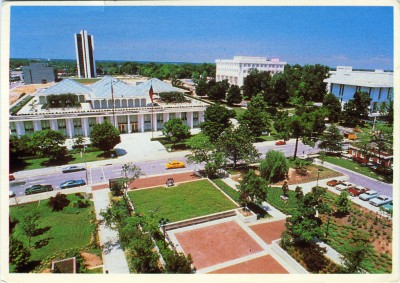
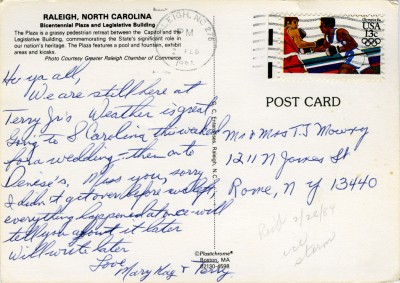

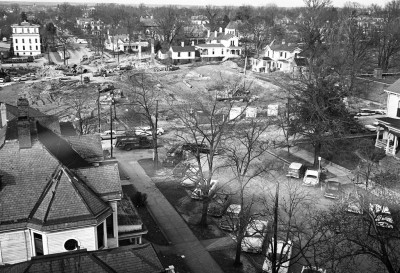
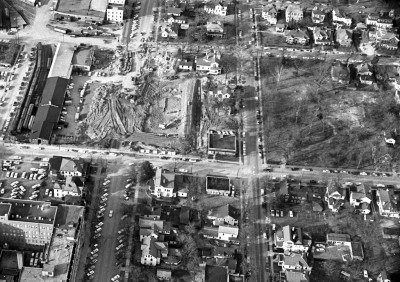
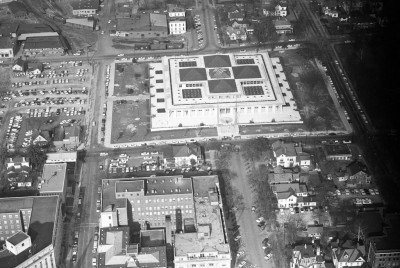

 Sign up for the Newsletter
Sign up for the Newsletter
04/24/2015
A heinous and atrocious crime!!! Thanks for the photos.
04/24/2015
Is this the same point in time that North Street was decimated?
We should push for the original boundary streets, North, South, East, and West be united with a walking path.
04/29/2015
Good idea NCMYK!
01/18/2016
Thank you for the history and view down Halifax Avenue. My great great grandfather, James Maglenn, lived at 214 Halifax and I have been looking for photographs of that area.